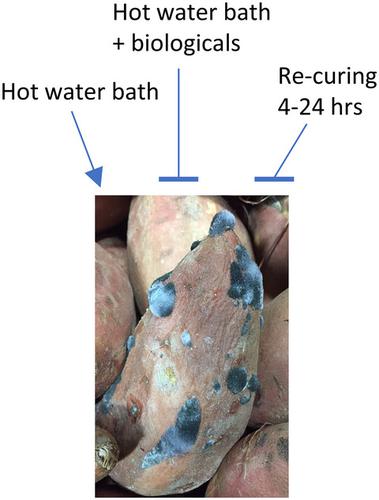当前位置:
X-MOL 学术
›
Plant Pathol.
›
论文详情
Our official English website, www.x-mol.net, welcomes your
feedback! (Note: you will need to create a separate account there.)
Hot‐water baths, biologicals and re‐curing effects on rhizopus soft rot during sweetpotato packing
Plant Pathology ( IF 2.3 ) Pub Date : 2020-01-01 , DOI: 10.1111/ppa.13126 R. R. Sweany 1 , D. H. Picha 2 , C. A. Clark 1
Plant Pathology ( IF 2.3 ) Pub Date : 2020-01-01 , DOI: 10.1111/ppa.13126 R. R. Sweany 1 , D. H. Picha 2 , C. A. Clark 1
Affiliation

|
Rhizopus soft rot (RSR) caused by Rhizopus stolonifer is one of the most devastating postharvest diseases of sweetpotato. It causes greatest losses when sweetpotatoes are removed from storage, washed and packed for marketing. The disease has been managed effectively by prophylactic application of synthetic fungicides on the packing line. However, there is increasing demand for alternative management strategies that do not rely on prophylactic use of synthetic fungicides. While curing immediately after harvest is a standard industry practice, re‐curing after storage is not widely practised for postharvest disease management. In this study, the use of hot‐water baths, biocontrol agents and re‐curing after storage were investigated as potential replacements for synthetic fungicides that are widely used during sweetpotato packing. Hot‐water baths at 52 °C for 10–15 min immediately after inoculation reduced RSR incidence by as much as 75%, but increased susceptibility to post‐treatment Rhizopus infection. The biological control product Bio‐Save® (a.i. Pseudomonas syringae strain ESC‐10), used in conjunction with a 4 min water bath at 52 °C, gave similar protection (1.2% RSR, t = −1.7, P = 0.514) as the industry standard treatment with dicloran. Re‐curing for as little as 4 h after washing roots significantly reduced RSR and deserves further evaluation to optimize conditions and determine its influence on other postharvest diseases.
中文翻译:

甘薯包装过程中热水浴,生物制剂和根瘤菌对根腐菌软腐的影响
引起的根霉软腐病(RSR)匍枝根霉是甘薯最具破坏性的收获后疾病之一。当从存储库中取出甘薯,清洗并包装以供销售时,它将造成最大的损失。通过在包装生产线上预防性使用合成杀真菌剂可以有效控制这种疾病。然而,对不依赖于预防性使用合成杀真菌剂的替代管理策略的需求日益增加。尽管收获后立即进行固化是一种标准的行业惯例,但在储藏后疾病管理中并未广泛采用存储后的重新固化方法。在这项研究中,研究了热水浴,生物防治剂的使用以及储藏后的再固化,以作为甘薯包装过程中广泛使用的合成杀菌剂的潜在替代品。根霉菌感染。与52°C下4分钟的水浴一起使用的生物防治产品Bio‐Save®(ai假单胞菌丁香菌株ESC-10)具有与以下类似的保护作用(1.2%RSR,t = −1.7,P = 0.514)工业标准的双氯仑治疗。洗根后再固化仅4小时,RSR明显降低,值得进一步评估以优化条件并确定其对其他收获后疾病的影响。
更新日期:2020-01-01
中文翻译:

甘薯包装过程中热水浴,生物制剂和根瘤菌对根腐菌软腐的影响
引起的根霉软腐病(RSR)匍枝根霉是甘薯最具破坏性的收获后疾病之一。当从存储库中取出甘薯,清洗并包装以供销售时,它将造成最大的损失。通过在包装生产线上预防性使用合成杀真菌剂可以有效控制这种疾病。然而,对不依赖于预防性使用合成杀真菌剂的替代管理策略的需求日益增加。尽管收获后立即进行固化是一种标准的行业惯例,但在储藏后疾病管理中并未广泛采用存储后的重新固化方法。在这项研究中,研究了热水浴,生物防治剂的使用以及储藏后的再固化,以作为甘薯包装过程中广泛使用的合成杀菌剂的潜在替代品。根霉菌感染。与52°C下4分钟的水浴一起使用的生物防治产品Bio‐Save®(ai假单胞菌丁香菌株ESC-10)具有与以下类似的保护作用(1.2%RSR,t = −1.7,P = 0.514)工业标准的双氯仑治疗。洗根后再固化仅4小时,RSR明显降低,值得进一步评估以优化条件并确定其对其他收获后疾病的影响。











































 京公网安备 11010802027423号
京公网安备 11010802027423号